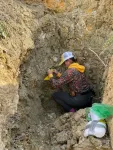(Press-News.org) Autistic youth who were born in underserved neighborhoods are more likely to have greater attention deficit hyperactivity disorder (ADHD) symptoms than those born in communities with more resources. This is one finding of a new study led by researchers at the UC Davis MIND Institute.
This is the first time researchers have investigated how neighborhood factors are associated with ADHD in autistic and non-autistic children. The study provides new insights into mental health conditions and has the potential to inform public policy changes to improve health equity.
It was published in the journal JCPP Advances.
“We found that some neighborhood factors are strongly related to ADHD symptoms in autistic children,” said Catrina Calub, the first author on the paper. Calub is a postdoctoral researcher in the laboratory of Julie Schweitzer, a professor in the Department of Psychiatry and Behavioral Sciences and the MIND Institute.
“In this study, we didn't find this effect in typically developing kids or in kids with other developmental disabilities, only in the autistic children. It suggests that when autistic kids live in neighborhoods with fewer resources, they tend to have more pronounced ADHD symptoms,” Calub said.
ADHD symptoms can include higher rates of inattention, hyperactivity and impulsive behavior.It is associated with:
Challenges in school performance and relationships with friends
Lower self-esteem and greater risk for anxiety and depression
Higher potential for substance use disorders and accidents
Emotional dysregulation and conduct problems
Study expands findings from long-term research
The researchers used data from two studies: the decades-long Childhood Autism Risks from Genetics and the Environment (CHARGE) study led by Irva Hertz-Picciotto at the MIND Institute and the ReCHARGE follow-up project.
CHARGE and ReCHARGE assess how genetics, environment and other factors affect development from early childhood (2–5 years) through adolescence (8-20 years).
The team looked at 246 autistic children, 85 with developmental delays (without autism), and 193 who were neurotypical. Then, they applied the Child Opportunity Index, which uses census data to track over 30 neighborhood traits. These traits include socioeconomics, green space, single-parent households and concentration of early childhood education centers.
The index encompasses three domains: education, health and environment, and social and economic resources. Higher scores are linked to better childhood health. Of the three domains, the education and social and economic resources scores were most strongly related to ADHD symptoms.
The analysis showed the Child Opportunity Index scores at birth were a strong predictor for ADHD symptoms in adolescence in the autistic children but not in the other groups. Calub noted that the finding was unexpected.
“These results are quite concerning,” Calub said. “Those with both autism and ADHD are already more likely to have additional challenges — behaviorally, cognitively, emotionally and socially. Being born in a low-income neighborhood puts them at an even greater disadvantage. This just adds to the evidence that more resources are needed for underserved areas and specifically for those who have conditions like autism.”
The need for a larger, more diverse sample
Calub pointed out that more research is needed to determine if the results would apply to a larger group.
"It will be important for future studies to be larger and more diverse. That should help us learn whether neighborhood conditions might also influence ADHD symptoms in other groups such as youth without autism, or in Black, Asian and Native American individuals, who were under-represented in our sample," Calub added.
These findings also offer clues for how to target preventive strategies to reduce the risk of increased ADHD symptoms, noted Schweitzer, who was also a co-author on the study.
“ADHD is highly prevalent in the general population and is common in autistic youth. If we can find ways to increase resources in these neighborhoods, we have the potential to improve academic, social, mental and physical health outcomes, particularly for autistic youth, and also decrease long-term economic costs,” Schweitzer explained.
Calub and Schweizer believe the study’s findings should encourage policymakers to provide more resources for underserved communities. In addition, they hope including the Child Opportunity Index and other neighborhood metrics could provide new insights into future studies to inform policy.
Co-authors on the study include Irva Hertz-Picciotto and Deborah Bennett, both in the Department of Public Health Sciences at UC Davis. Read the full study.
END
ADHD symptoms in autistic children linked to neighborhood conditions
Study finds poverty, lack of services may play a role
2024-08-09
ELSE PRESS RELEASES FROM THIS DATE:
Many survey respondents rated seeking out sexually explicit ‘deepfakes’ as more acceptable than creating or sharing them
2024-08-09
Content warning: This post contains details of sharing intimate imagery without consent that may be disturbing to some readers.
While much attention on sexually explicit “deepfakes” has focused on celebrities, these non-consensual sexual images and videos generated with artificial intelligence harm people both in and out of the limelight. As text-to-image AI models grow more sophisticated and easier to use, the volume of such content is only increasing. The escalating problem led Google to announce last week that it will work to filter out these deepfakes in search results, and the Senate recently passed ...
Strike Force: Utah State leads collaborative $2.3M NSF grant to study earthquake critical zones
2024-08-09
LOGAN, UTAH, USA -- Utah State University geoscientist Alexis Ault recalls the devastating aftermath of back-to-back 7.8 and 7.6-magnitude earthquakes on Feb. 6, 2023, near the Turkey-Syria border that killed more than 50,000 people and displaced millions.
“We witnessed the destruction firsthand, as well as the resilience of the country and population trying to get their footing and rebuild,” says Ault, associate professor in USU’s Department of Geosciences, who traveled to the disaster site about six months after ...
Achieving quantum memory in the hard X-ray range
2024-08-09
Light is an excellent carrier of information used not only for classical communication technologies but also increasingly for quantum applications such as quantum networking and computing. However, processing light signals is far more complex, compared to working with common electronic signals.
An international team of researchers including Dr. Olga Kocharovskaya, a distinguished professor in the Department of Physics and Astronomy at Texas A&M University, has demonstrated a novel way of storing and releasing X-ray pulses at the single photon level — a concept first ...
Study shows donor kidneys with toxoplasma do not increase risks for transplant patients
2024-08-09
A new study from UC Davis Health could help to increase the supply of donor kidneys.
Researchers have found that transplant patients who receive kidneys infected with the parasite toxoplasma have virtually the same outcomes as those who receive toxoplasma-negative organs.
Despite longstanding concerns, those who received kidneys from toxoplasma antibody positive donors (TPDs) had almost identical mortality and rejection rates. The research was published in Transplant International.
“Organs from donors who were positive for toxoplasma did ...
Advanced MRI scans help identify one in three concussion patients with ‘hidden disease’
2024-08-09
Offering patients with concussion a type of brain scan known as diffusion tensor imaging MRI could help identify the one in three people who will experience persistent symptoms that can be life changing, say Cambridge researchers.
Around one in 200 people in Europe every year will suffer concussion. In the UK, more than 1 million people attend Emergency Departments annually with a recent head injury. It is the most common form of brain injury worldwide.
When a patient in the UK presents at an Emergency Department with head injury, they ...
Psychological bias links good deeds to a belief in God, research says
2024-08-09
Experiments conducted by UC Merced researchers find that people who perform good deeds are far more likely to be thought of as religious believers than atheists. Moreover, the psychological bias linking kindness and helpfulness with faith appears to be global in scale.
Research on the mental link between moral behavior and religious belief goes back more than a decade. Prior research, however, emphasized the dark side of this equation, with participants asked whether they assumed it was more probable that a serial killer believed in God or was an atheist (people in nations all over the planet thought the latter ...
Greenland megatsunami led to week-long oscillating fjord wave
2024-08-09
In September 2023, a megatsunami in remote eastern Greenland sent seismic waves around the world, piquing the interest of the global research community.
The event created a week-long oscillating wave in Dickson Fjord, according to a new report in The Seismic Record.
Angela Carrillo-Ponce of GFZ German Research Centre for Geoscience and her colleagues identified two distinct signals in the seismic data from the event: one high-energy signal caused by the massive rockslide that generated the tsunami, and one very long-period (VLP) signal that lasted over a week.
Their analysis of the VLP signal—which was detected as far as 5000 kilometers away—suggests ...
Machine learning approach helps researchers design better gene-delivery vehicles for gene therapy
2024-08-08
Gene therapy could potentially cure genetic diseases but it remains a challenge to package and deliver new genes to specific cells safely and effectively. Existing methods of engineering one of the most commonly used gene-delivery vehicles, adeno-associated viruses (AAV), are often slow and inefficient.
Now, researchers at the Broad Institute of MIT and Harvard have developed a machine-learning approach that promises to speed up AAV engineering for gene therapy. The tool helps researchers engineer the protein shells of AAVs, called capsids, to have multiple desirable ...
Bacteria encode hidden genes outside their genome—do we?
2024-08-08
NEW YORK, NY (Aug. 8, 2024) -- Since the genetic code was first deciphered in the 1960s, our genes seemed like an open book. By reading and decoding our chromosomes as linear strings of letters, like sentences in a novel, we can identify the genes in our genome and learn why changes in a gene’s code affect health.
This linear rule of life was thought to govern all forms of life—from humans down to bacteria.
But a new study by Columbia researchers shows that bacteria break that rule and can create free-floating and ephemeral genes, raising the possibility that similar genes exist outside ...
Assistant professor's $1.1M NASA grant to develop computational tool aiding hypersonic vehicle design
2024-08-08
STARKVILLE, Miss.—NASA is awarding a Mississippi State University assistant professor a $1.13 million grant to develop a new simulation tool to aid the design of hypersonic vehicles used in space exploration.
Vilas Shinde of MSU’s Department of Aerospace Engineering won the grant to develop a new flow stability and transition analysis tool, which will aid researchers and aircraft designers in understanding and predicting changes associated with the boundary layer—air flow in the vicinity of an aircraft’s ...
LAST 30 PRESS RELEASES:
Global psychiatry mourns Professor Dan Stein, visionary who transformed mental health science across Africa and beyond
KIST develops eco-friendly palladium recovery technology to safeguard resource security
Statins significantly reduce mortality risk for adults with diabetes, regardless of cardiovascular risk
Brain immune cells may drive more damage in females than males with Alzheimer’s
Evidence-based recommendations empower clinicians to manage epilepsy in pregnancy
Fungus turns bark beetles’ defenses against them
There are new antivirals being tested for herpesviruses. Scientists now know how they work
CDI scientist, colleagues author review of global burden of fungus Candida auris
How does stroke influence speech comprehension?
B cells transiently unlock their plasticity, risking lymphoma development
Advanced AI dodel predicts spoken language outcomes in deaf children after cochlear implants
Multimodal imaging-based cerebral blood flow prediction model development in simulated microgravity
Accelerated streaming subgraph matching framework is faster, more robust, and scalable
Gestational diabetes rose every year in the US since 2016
OHSU researchers find breast cancer drug boosts leukemia treatment
Fear and medical misinformation regarding risk of progression or recurrence among patients with breast cancer
Glucagonlike peptide-1 receptor agonists and asthma risk in adolescents with obesity
Reviving dormant immunity: Millimeter waves reprogram the immunosuppressive microenvironment to potentiate immunotherapy without obvious side effects
Safety decision-making for autonomous vehicles integrating passenger physiological states by fNIRS
Fires could emit more air pollution than previously estimated
A new way to map how cells choose their fate
Numbers in our sights affect how we perceive space
SIMJ announces global collaborative book project in commemoration of its 75th anniversary
Air pollution exposure and birth weight
Obstructive sleep apnea risk and mental health conditions among older adults
How talking slows eye movements behind the wheel
The Ceramic Society of Japan’s Oxoate Ceramics Research Association launches new international book project
Heart-brain connection: international study reveals the role of the vagus nerve in keeping the heart young
Researchers identify Rb1 as a predictive biomarker for a new therapeutic strategy in some breast cancers
Survey reveals ethical gaps slowing AI adoption in pediatric surgery
[Press-News.org] ADHD symptoms in autistic children linked to neighborhood conditionsStudy finds poverty, lack of services may play a role



